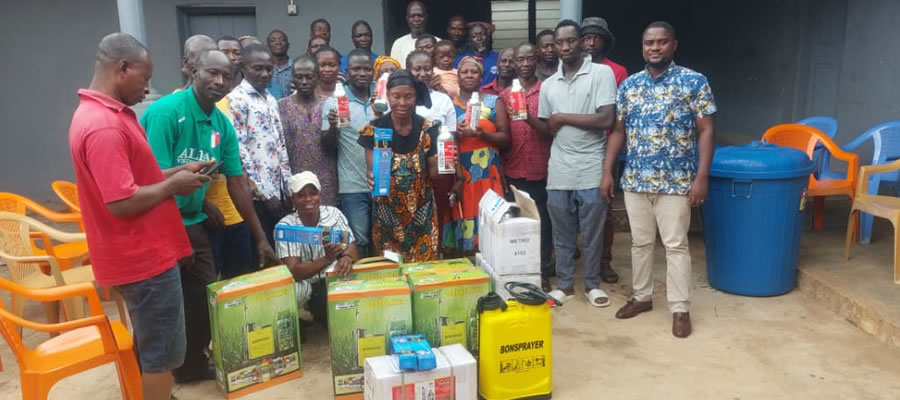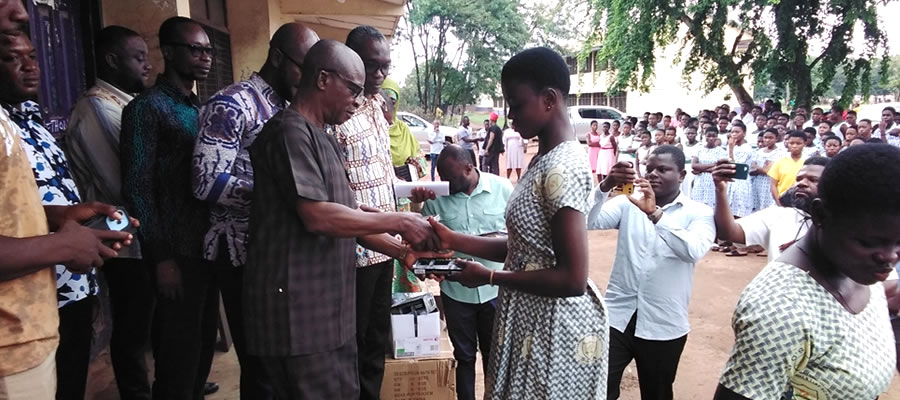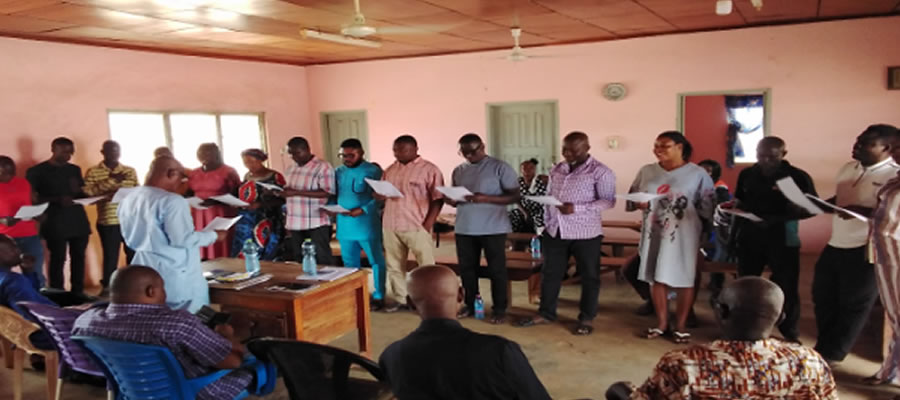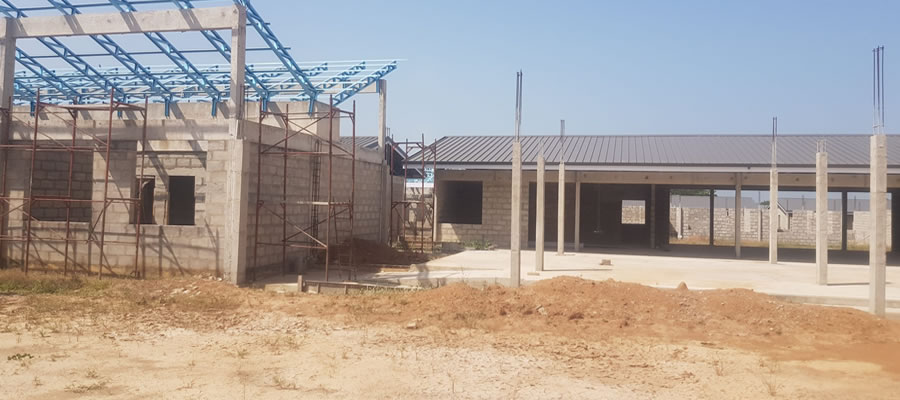

Roads
The Municipality has road networks linking all the communities in the Municipality. However, only the main towns of Odomase, Chiraa, Dumasua Fiapre, and Nsoatre are linked with tarred roads from the Regional capital Sunyani. The roads to these towns do not have drains on the sides to carry run-off water from rain, hence the rapid deterioration of the roads through erosion. Apart from the above mentioned towns, the remaining towns and rural communities in the Municipality are linked with either foot paths or roads that are not motorable throughout the year.
Telecommunication
Out of the seven area councils in the district only Koduakrom as an area council capital with its satellite communities is without telecommunication services. Other communities like Kwabenakuma krom, Abronye, Adei Boreso, etc all do not have access to telecommunication services.
Information Communication Technology
Introduction
Information communication technology (ICT) development has seen significant growth over the past years. It has brought about a positive transformation in the socio economic development of the country. For the first time in Ghana, the 2010 Population and Housing Census gathered data on access to and use of ICT by individuals and households. This Chapter presents information on ownership and access to mobile phones, desktop or laptop computers by individuals or households, the use of internet facility either at home, internet café and mobile phones ownership.
Use of Internet
Internet access is not only via computer, but also by mobile phones, game machine and digital television. Table 5.1 shows internet facility usage by sex in the Municipality. Close to six percent (5.9%) of the population 12 years and older in the District uses internet facility which is higher than the Regional percentage of 3.4%. Twice as many more males (69.3%) than females (30.7%) use the internet in the District.
Household Ownership of Desktop or Laptop Computer
Ownership of desktop or laptop computers by households is important in enhancing self-education by the use of internet. Table 5.2 presents data on households having desktop or laptop computers. About 8.3 percent, that is 1,636 of the total households in the District have desktop or laptop computers. Males in the households that own desktop or laptop computers are 9.9 percent and females 5.8 percent.
HOUSING CONDITIONS
Introduction
Housing refers to the physical structure that mankind uses for shelter and the environment of the structure including all necessary services, facilities, equipment and devices needed or desired for the physical and mental health and social wellbeing of the family and individual.
Housing performs physical, social and economic functions. As a physical unit, it protects man against the elements of weather, risk of victimization by street crime and enclosure for domestic behavior. As a social unit, it combines with food and clothing to form basic essentials of life. As an economic unit, it is an area of investment and, hence used as a security. The physical structures of the house include the types of materials used for the outer walls and the floors, the roof type, as well as the bathing, kitchen and toilet conditions. These are among other amenities that make a house conducive and comfortable in addition to access to water for both domestic activities and for drinking and will be discussed further in this chapter.
Housing Stock
Table 8.1 presents stock of houses and household by type of locality. Data from the 2010 Population and Housing Census show that Sunyani West Municipality has 19,716 households and an average household size of 4.3. The data further show that there are 10,715 stocks of houses in the District, of which 6,781 (63.3%) and 3,934 (36.7%) t are found in the urban and rural areas respectively. The average household per house is approximately two (1.8), which is higher than the regional average of 1.5, while the population per house is about eight (7.9) persons.
Type of Dwelling, Holding and Tenancy Arrangement
Type of dwelling
Table 8.2 presents the type of occupied dwelling unit by sex of household head and type of locality. Rooms in compound houses are the predominant occupied units by households in the Municipality. It accounts for 57.3 percent of the dwelling units. Separate houses constitute the second largest proportion of households’ occupied dwelling units (27.3%). Also, significant are the proportions of households using semi-detached houses (5.6%), flats/apartments (3.8%) and huts (2.9%) as their dwelling units. Close to two percent (1.8%) of households use kiosks/containers and uncompleted buildings as their occupied housing units.
More than half of female headed (62.5%) and male headed (53.8%) households occupy rooms in compound houses compared to separate housing units which has slightly more male headed (29.7%) households than female (23.8%). The use of rooms in compound houses for dwelling purposes by household heads is higher in the urban areas (63.9%) than in the rural areas (38.3%). About 5 per cent of urban households occupy flats/apartments (4.5%) whilst 1.7%) are in rural areas. However, the proportion of female headed households occupying separate houses is twice higher for rural areas (45.4%) than in urban areas (21.1%).
House Ownership status
Investors in real estate are interested in the tenure status of households occupying living spaces. A primary distinction between owner-occupied dwellings and others would be particularly meaningful for housing programmes in general. Table 8.3 shows ownership status of dwelling by sex of household head and type of locality. More than a third of female headed households (45.5%) and male headed households (45.2%) occupy housing units owned by a household member or relative, compared to nearly a one- third of male headed households (32.5%) and more than a one- quarter of female headed households (27.6%) who occupies houses owned by other private individual.
One out of every two households occupy dwelling unit owned by a household member in the rural areas while two out of every five household heads occupy dwelling units owned by a household member in the urban locality. Also, significant is the proportion of housing units 53 which are owned by other private individuals, which are more than a quarter in urban (31.9%) and rural (26.8%) localities.
Construction Materials
Table 8.4 presents main construction material for outer wall of dwelling unit by type of locality. The type of material used for constructing various parts of dwelling unit determines the durability and life span of the dwelling unit. The main material for outer wall of dwelling unit is cement block/concrete. More than two thirds of dwelling units in the Municipality have outer walls constructed with cement blocks or concrete while a little above one-fifth (20.9%) of the dwelling units are constructed with mud bricks or earth. As much as 78.8 percent of dwelling units in the urban areas have walls made of cement blocks or concrete compared to mud brick or earth (11.6%). In the rural localities of the Municipality there is not much difference between dwelling units with outer walls constructed with cement block or concrete (43.3%) and mud bricks or earth (46.3%).
Floor of Dwelling Units
Table 8.5 shows main construction materials for the floor of dwelling unit by type of locality.
Cement or concrete (81.4%) and earth/mud (14.7%) are the two main construction materials used for floors in the Municipality with a similar trend for both urban and rural localities.
Roofing of the dwelling units
Table 8.6 presents main construction material for roofing of dwelling unit by type of locality.
Nine out of every 10 dwelling units in the Municipality are roofed with metal sheets. The trend is similar for urban (95.9%) and rural (80.6%) localities but the former being much higher than the latter. Though not many, a significant number of households use raffia, especially in the rural areas for roofing.
Room Occupancy
Table 8.7 presents data on household size and number of sleeping rooms occupied in dwelling unit. With an average household size of 4.3, a cursory look at Table 8.7 shows that majority, about 3 out of every 5 households (62.6%) in the District occupy one sleeping room while a one- fifth (21.4%) use two rooms as their dwelling unit.
In terms of distribution of households according to number of rooms occupied, the data shows that virtually all single member households (96.3 %) occupy one room, while nearly two-thirds of households with four members (64.7%) and household with five members (54.3%) occupy one room. Also significant is the percentage of seven and eight member households that occupy single rooms which results in overcrowding of the people in the Municipality.
Access to utilities and household facilities
Information on household utilities and facilities give clear indication of how accessible certain basic facilities and necessities are to communities.
Main Source of Lighting
The distribution of households in living quarters by type of lighting is useful in determining the extent of electricity coverage in the Municipality for planning purposes. Figure 8.1 and Table 8.8 presents data on sources of lighting for households. Electricity and flashlight/Torch are the main sources of lighting for households in the Municipality with kerosene lamp being the third most important source of lighting. There are more households in urban areas that use electricity as source of lighting than in rural areas. By contrast, more rural households reported using flashlight/Torch and kerosene lamp in lighting than urban households.
Table 8.8 also presents the main sources of lighting for dwelling units by type of locality. The table shows that the most common source of lighting in the Municipality is electricity from the main grid (67.3%). Electricity from the main grid is also widely used in both urban and rural households but more in urban (76.2%) than rural (41.5%) households. The next common source is flash light/torch (23.0%) for households in the Municipality, but the use in rural (42.4%) nearly fourfold that of the urban (16.3%). Kerosene lamp is third largest source, also used more in rural households (12.5%) than urban (5.1%).
Main source of fuel for cooking
Table 8.9 shows the main source of cooking fuel for households in the Municipality. Majority of households use wood (48.3%) as their main source of fuel for cooking, charcoal (28.3%). A household that uses gas as their main of source of cooking represents 13.4 percent. The least source of cooking fuel used by the households is saw dust and animals residuals (0.1%) each.
The use of wood is higher in the rural areas (71.3%) than the urban (40.3%). However, the use of charcoal and gas is higher in urban (33.2%, 15.1%) than rural (8.6%, 14.0%) respectively
Cooking space used by households
The Table 8.10 shows the type of cooking space used by households in the Municipality. In all, 26.4 percent of households use open space in compound. Twenty – six percent use separate rooms for exclusive use of households. Those who use bed room /hall/living room and other not specified place represents less than one percent (0.5% and 0.4%) respectively. The use of verandah as space for cooking is common in urban areas than it is in rural (12.1%), closely follows is the use of separate room for exclusive use of household in urban areas is 24.2 percent while rural areas is 31.1 percent and the least is other not specified spaces used as cooking space less than one percent in both urban and rural areas (0.5% and 0.4%) respectively.
Date Created : 11/20/2017 5:34:41 AM













 facebook
facebook
 twitter
twitter
 Youtube
Youtube
 +233 593 831 280
+233 593 831 280 0800 430 430
0800 430 430 GPS: GE-231-4383
GPS: GE-231-4383 info@ghanadistricts.com
info@ghanadistricts.com Box GP1044, Accra, Ghana
Box GP1044, Accra, Ghana